36 FLOAT RC2 & R
Installing Your Fork | Before You Ride | Setting Sag | Adjusting Rebound | Adjusting High-Speed Compression | Adjusting Low-Speed Compression | Changing Travel | Service Intervals | Important Safety Information
|
weight RC2 |
5.05 lbs./2.29 kg | |
|
travel The total amount the shock or fork compresses. On a shock it is measured using the eye-to-eye distance or shaft travel. |
6.3 in. / 160 mm | |
|
features/adjustments RC2 |
low-speed compression, high-speed compression, internal bottom-out resistance, air spring pressure, rebound | |
|
features/adjustments R |
internal bottom-out resistance, air spring pressure, rebound | |
|
spring/damper type |
air/RC2 FIT damper | |
|
intended use |
downhill A style of riding defined by steep descents down insanely steep mountains, hills or, in some cases, buildings. Downhill bicycles and their components are generally the strongest available. Hence, the 40 and DHX 5.0., all-mountain A style of bicycle riding that melds the stamina and conditioning required of cross-country with the technical abilities of freeriding., freeride A style of riding that is defined by short course technical acrobatics and athletes that defy gravity. Generally, the bikes and components required for freeriding are stronger and heavier than their lightweight cross-country brethren. Combine the aerial pyrotechnics of freeriding with some longer trails and courses, as is typical of cross-country riding, and now you're looking at all-mountain riding. | |
|
color |
FLOAT Gold |
Be sure your fork is properly installed before proceeding. Clicking on the link above will take you to a new page.
Check that the 20mm axle pinch bolts and crown pinch bolts are properly adjusted and tightened.
Clean the outside of your fork with soap and water and wipe dry with a soft dry rag. Do not spray water directly on the seal/upper tube junction. Do not use a high pressure washer on your fork.
Inspect entire exterior of fork for damage. The fork should not be used if any of the exterior parts appear to be damaged. Please contact your local dealer or FOX Racing Shox for further inspection and repair.
Check headset adjustment. If loose, adjust according to manufacturer’s recommendations.
Check that brake cables or hoses are properly fastened.
Check that the front and rear brakes operate properly on flat land.
You can also view a Flash video on Setting Sag.
To get the best performance from your fork, it is necessary to set and adjust sag Amount a shock or fork compresses with the rider sitting on the bike in a normal riding position. Best measured with an assistant holding your bike up and with the rider in full riding gear. On a fork, it is helpful to place a ZIP tie around one of the upper tubes.. Generally, sag should be set to 15 – 25% of total fork travel.
Unscrew the center blue aircap (shown below) on top of the left fork leg to expose the Schrader valve.
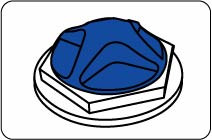
Attach a FOX Racing Shox High Pressure Pump to the Schrader valve.
Using the 36 FLOAT Air Spring Setting Guidelines table below, pump your fork to the appropriate setting using the FOX High Pressure Pump, then remove the pump.
Install a zip tie with light friction on the upper tube and push it down until it contacts the fork seal.
Carefully sit on the bike and assume a normal riding position. The fork should compress slightly.
Being careful not to further compress the fork, dismount the bicycle. Measure the distance between the seal and the zip tie. This distance is sag.
Compare your sag measurement
to the Sag Setup table below.
If your sag is lower than on the table, screw on the pump fitting,
note the current air pressure setting and depress the black bleed-valve
to reduce the gauge pressure by 5 psi. Measure sag again and repeat adjustment,
if necessary.
If your sag is higher than on the table, screw on the pump fitting,
note the current air pressure setting and pump to increase the gauge pressure
by 5 psi. Measure sag again and repeat adjustment if necessary.
Screw the blue aircap back on, and go ride.
|
Rider Weight |
Air Pressure |
|
< 125 lbs. |
45 psi |
|
125 - 135 lbs. |
48 psi |
|
135 - 145 lbs. |
50 psi |
|
145 - 155 lbs. |
53 psi |
|
155 - 170 lbs. |
55 psi |
|
170 - 185 lbs. |
62 psi |
|
185 - 200 lbs. |
69 psi |
|
200 - 215 lbs. |
76 psi |
|
215 - 230 lbs |
83 psi |
|
230 - 250 lbs. |
90 psi |
|
Travel |
XC/Race FIRM |
Freeride PLUSH |
|
100 mm (4") |
15mm (1/2") |
20mm (3/4") |
|
130 mm (5") |
20mm (3/4") |
32mm (1.25") |
|
160 mm (6.3") |
20mm (3/4") |
40mm (1.5") |
|
Symptom |
Remedy |
|
Too much sag |
(+) air pressure in 5psi increments |
|
Too little sag |
(-) air pressure in 5psi increments |
|
Excessive bottoming |
(+) air pressure in 5psi increments |
|
Harsh ride; full travel not utilized |
(-) air pressure in 5psi increments |
The rebound knob (shown below) is located on the top of the right fork leg, and has 15 clicks of adjustment. Rebound controls the speed at which the fork extends after compressing. Turning the knob clockwise A motion that proceeds from the top to the right, then down and then to the left, and back to the top, like the clock's hands. slows down rebound; turning the knob counterclockwise speeds up rebound. As a starting point, turn the rebound adjuster knob all the way clockwise (full in) until it stops, then turn counterclockwise (out) 8 clicks.
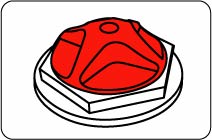
|
Knob Setting |
Setting Description |
Tuning Tips |
Setup Tips |
|
|
Slow Rebound |
Too slow and your fork will pack down and ride harsh. |
If you increase your spring rate Force required to compress a spring one inch. or air pressure, you will need to slow down your rebound |
|
8 (Factory setting) |
Average Rebound |
||
|
|
Fast Rebound |
Too fast and you will experience poor traction and wheel hop. |
If you decrease your spring rate or air pressure, you will need to speed up your rebound setting. |
High-speed compression damping Oil or air damping resistance felt when trying to compress a shock or fork. controls the force it takes to move the fork through its travel and how the wheel reacts to a bump. This adjuster rotates to stops at each end and has 15 clicks of adjustment. It is preset from the factory at 1 click in from the full out (counterclockwise) position. The knob is protected by the black protective cap. Never ride your FOX 36 without the black protective cap.
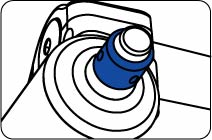
|
Knob Setting |
Setting Description |
Tuning Tips |
|
|
Slow Compression |
Maximum wheel traction and bump compliance. If setting is too soft, you may bottom often on square-edged hits and G-outs. |
|
1 (Factory setting) |
Average Compression |
|
|
|
Firm Compression |
Reduces bottom-out and provides maximum bump absorption. If setting is too firm, you may experience a harsh ride with bad traction and use too little available travel. |
The high-speed compression adjuster is equipped with a maximum “Boost” setting. This setting offers increased bump force resistance well beyond the adjuster's linear range up until the stop at full firm (clockwise). To enable the “Boost” feature, turn the high-speed compression knob to the full in (clockwise) position, to the stop with firm hand torque. You can use a 3mm hex key to assist in turning the knob to the full in position or to untorque when de-tuning the Boost feature.
Low-speed compression damping controls the influence of the rider’s weight shifts and bike attitude under braking. This adjuster rotates to stops at each end and has 17 clicks of adjustment. It is preset from the factory at 1 click in from the full out (counterclockwise) position. The knob is protected by the black protective cap. Never ride your FOX 36 without the black protective cap.
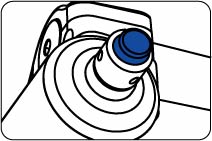
|
Knob Setting |
Setting Description |
Tuning Tips |
|
|
Slow Compression |
Maximum wheel traction and bump compliance. Too soft and you maybe have excessive brake dive and wallowy feel. |
|
1 (Factory setting) |
Average Compression |
|
|
|
Firm Compression |
Resists brake dive and keeps the fork up in the travel. Too firm and you may have poor traction in loose conditions. |
The 36 VAN is equipped with a patent-pending Internally Adjustable Hydraulic Bottom-Out Control System. This feature can be adjusted inside the cartridge by FOX Racing Shox or an Authorized Service Center. It comes preset from the factory at the FIRM setting.
Travel on your 36 FLOAT fork can be changed by rearranging the internal travel spacers. After changing travel check the fork for proper operation before riding. If there is noticeable play in the fork or if it makes strange noises, disassemble the fork and check for complete number and correct orientation of spacers.
36 FLOAT forks can be reduced in travel, but they cannot be increased beyond 160mm.
32mm 6-sided socket
10mm socket
Small screwdriver
Torque wrench
2mm hex key wrench
Oil drain pan
1.5mm hex key wrench
Plastic-faced hammer
Measuring container w/ cc or mL increments
|
Quantity |
Part Number |
Part Name |
|
1 |
025-03-004-A |
1 qt. bottle of FOX Suspension Fluid (7 wt.) |
|
1 |
025-03-002-A |
5cc Pillow Pack of FOX FLOAT Fluid |
|
2 |
241-01-002-C |
Crush washer |
|
1 |
803-00-078 |
FLOAT Forx Air Piston Seal Kit (optional) |
Remove the blue air cap from the top of the left fork leg. Let the air out of the fork. Remove the left top cap with a 32mm socket 6-point socket wrench.
Loosen the bottom nut 3-4 turns with a 10mm wrench. With a plastic mallet, gently tap the bottom of the shaft to disengage it from the lower leg. Allow oil to drain into a bucket. Remove the bottom nut and crush washer.
Compress the fork as much as possible. The air piston will be visible about one inch below the top of the upper tube. Push the bottom of the air shaft upwards to push the air piston out of the top of the upper tube. Use a long, thin shaft screwdriver to push the bottom of the air shaft up through the hole in the bottom of the lower leg.
Pull the air-shaft assembly from the fork. Refer to the drawings below and add or remove the appropriate number of 30mm spacer(s) to achieve the desired travel. To achieve 130mm travel, use one 30mm spacer; 100mm travel, use both 30mm spacers.
Spacers snap onto the air shaft between the negative spring guide and topout plate, as shown in the travel spacer orientation drawing below.
Lubricate the U-cup seal on the air piston with FOX FLOAT Fluid and re-install the air shaft assembly into the upper tube. Be sure to orient the U-cup seal as shown in the Seal Orientation drawing below.
Push the shaft until it approaches the bottom hole of the fork. Do not push the shaft all the way through the bottom hole.
Turn the fork upside down. Measure and pour 30cc of FOX Suspension Fluid through the bottom hole.
Push the air shaft assembly up until the shaft comes through the bottom hole. Install the crush washer and bottom nut. Torque to 50 in-lbs.
Turn the fork right side up. Pour 5cc of FOX FLOAT Fluid on top of the air piston.
Lubricate the o-ring on the air topcap with FOX FLOAT Fluid.
Re-install the topcap and torque to 165 in-lbs.
Pump up the fork to the desired pressure and cycle it several times to check for proper operation.
Re-install the blue air cap.
You’re done. Go ride.
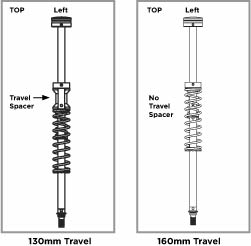
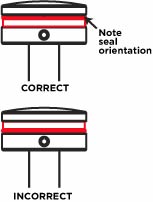
eng040